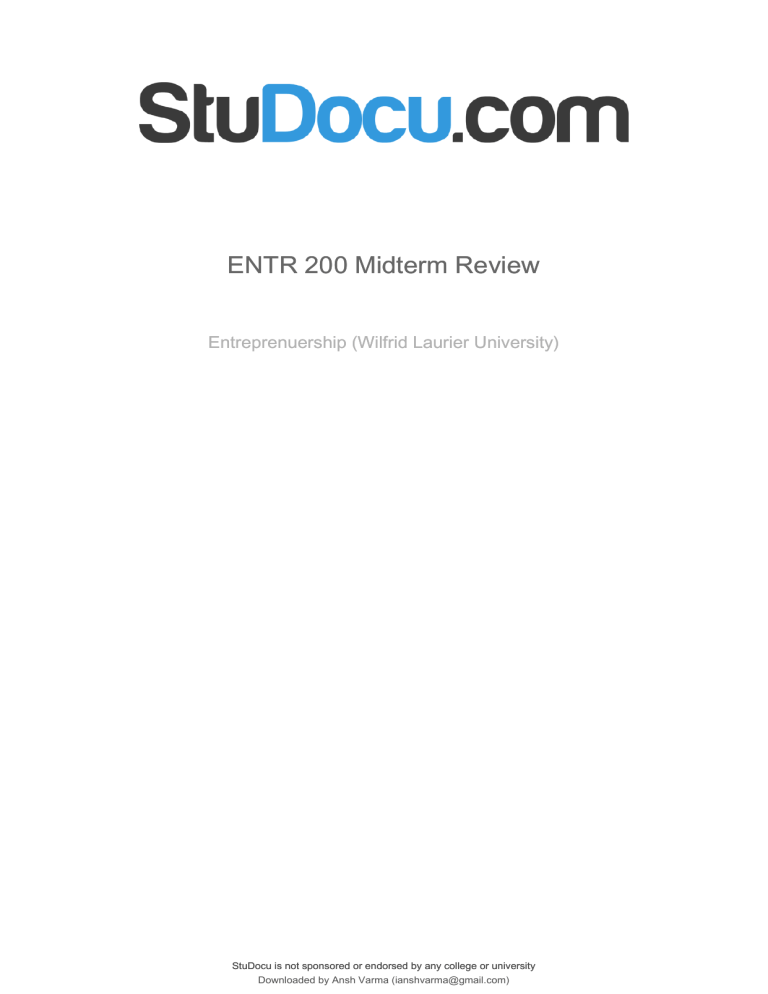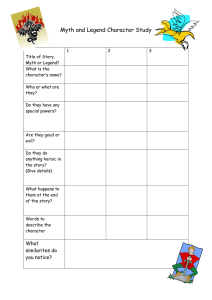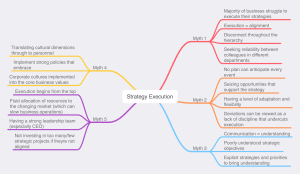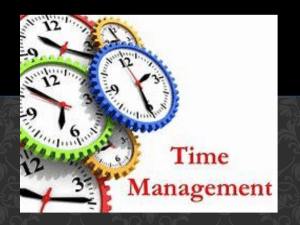
lOMoARcPSD|4529514 ENTR 200 Midterm Review Entreprenuership (Wilfrid Laurier University) StuDocu is not sponsored or endorsed by any college or university Downloaded by Ansh Varma (ianshvarma@gmail.com) lOMoARcPSD|4529514 ENTR 200 Midterm Review Entrepreneurship: a way of thinking, acting, and being that combines the ability to find or create new opportunities with the courage to act on them. Who is an entrepreneur: by taking action and putting ideas into practice, everyone “has what it takes” to be an entrepreneur. Downloaded by Ansh Varma (ianshvarma@gmail.com) lOMoARcPSD|4529514 Eight Components of the Entrepreneurship Method Identify your desired impact on the world Start with the means at hand Describe the idea today Calculate affordable loss Take small action Network and enroll others in your journey Build on what you learn Reflect and be honest with yourself Entrepreneurial Practices Downloaded by Ansh Varma (ianshvarma@gmail.com) lOMoARcPSD|4529514 the practice of play Developing a free and imaginative mind, allowing one to see a wealth of possibilities, a world of opportunities, and a pathway to more innovative ways of being entrepreneurial. the practice of empathy understanding the emotion, circumstances, intentions, thoughts, and needs of others. the practice of creation requires a general openness to the world and relates to unleashing our creative ability to create and find opportunities and solve problems. the practice of experimentation acting in order to learn trying something, learning from the attempt and building that learning into the next iteration. the practice of reflection helps make sense of all of the other actions required of play, empathy, creation and experimentation Entrepreneurial mindset The ability to quickly sense opportunities, take action, and get organized under uncertain conditions. This also includes the ability to persevere, accept and learn from failure, and get comfortable with a high level of discomfort. Innovation Driven Enterprises vs Small and Medium Enterprises (SME’s vs IDE’s) IDEs: require an investment to develop the innovation that they hope will be able to be scaled and marketed to a wide range of consumers. The upfront investment for these businesses is typically more risky. Given that these businesses are bringing new and un-tested ideas into the market, the probability that they will fail is higher. If they succeed, the potential for high growth is significant. To reach this wide audience, a successful IDE has the potential to create many jobs and have an impact on the market itself, and the economy overall. SMEs: seek to bring traditional ideas to local markets. success is based on their business acumen, execution of their idea, and local demand. The growth of SMEs is more linear, as they are unlikely to take off the way that successful IDEs can, but they too can create jobs and impact their communities. Downloaded by Ansh Varma (ianshvarma@gmail.com) lOMoARcPSD|4529514 SMEs are the backbone for many local economies– they help provide jobs at the local level that move people out of unemployment, especially during downturns in the economy. Failure and entrepreneurship By definition, a business failure is generally conceived as the termination of a commercial organization that has missed its goals and failed to achieve investors’ expectations, preventing the venture from continuing to operate and resulting in bankruptcy or liquidation. The reality is that majority of start-ups fail Failure is part of the process and can help your entrepreneurial success average, 47.8 percent of SMEs created in the goods-producing sector survived at least 10 years, compared with 42.9 percent in the service-producing sector all entrepreneurs experience countless small “fails” that require a quick reaction and sometimes a change in direction, often known as the pivot. Pivots for entrepreneurs include changing directions on such things as the product, customer segment, revenue model, or distribution channel Bird in hand/means-based entrepreneurship Downloaded by Ansh Varma (ianshvarma@gmail.com) lOMoARcPSD|4529514 Start with what you have, who you know, who you are, what I know The Corridor Principle: “The mere act of starting a venture enables entrepreneurs to see other venture opportunities they could neither see nor take advantage of until they had started their initial venture.”’ When being means driven, you start right away with what you have, you require fewer resources, and you have a unique competitive advantage 3 types of means: who I am, What I know, Who I know Myths of creativity 1. Eureka myth. New ideas sometimes seem to appear as a flash of insight. But research shows that such insights are actually the culminating result of prior hard work on a problem. This thinking is then given time to incubate in the subconscious mind as we connect threads before the ideas pop out as new eureka-like innovations. 2. Breed myth. Many people believe creative ability is a trait inherent in one’s heritage or genes. In fact, the evidence supports just the opposite. There is no such thing as a creative breed. People who have confidence in themselves and work the hardest on a problem are the ones most likely to come up with a creative solution. 3. Originality myth. There's a long-standing myth about intellectual property -- the idea that a creative idea is proprietary to the person who thought of it. But history and empirical research show more evidence that new ideas are actually combinations of older ideas and that sharing those helps generate more innovation. 4. Expert myth. Many companies rely on a technical expert or team of experts to generate a stream of creative ideas. Harder problems call for even more knowledgeable experts. Instead, research suggests that particularly tough problems often require the perspective of an outsider or someone not limited by the knowledge of why something can’t be done. 5. Incentive myth. The expert myth often leads to another myth, which argues that bigger incentives, monetary or otherwise, will increase motivation and hence increase innovation productivity. Incentives can help, but often they do more harm than good, as people learn to game the system. 6. Lone Creator myth. This reflects our tendency to rewrite history to attribute breakthrough inventions and striking creative works to a sole person, ignoring supportive work and collaborative preliminary efforts. Creativity is often a team effort, and recent research into creative teams can help leaders build the perfect creative troupe. 7. Brainstorming myth. Many consultants today preach the concept of brainstorming, or spontaneous group discussions to explore every possible approach, no matter how far-out, to yield creative breakthroughs. Unfortunately, there is no evidence that just "throwing ideas around" consistently produces innovative breakthroughs. Downloaded by Ansh Varma (ianshvarma@gmail.com) lOMoARcPSD|4529514 8. Cohesive myth. Believers in this myth want everyone to get along and work happily together to foster innovations. That's why we see so many "zany" companies where employees play foosball and enjoy free lunches together. In fact, many of the most creative companies have found ways to structure dissent and conflict into their process to better push their employees' creative limits. 9. Constraints myth. Another popular notion is that constraints hinder our creativity and the most innovative results come from people who have "unlimited" resources. Research shows, however, that creativity loves constraints. Perhaps companies should do just the opposite -- intentionally apply limits to leverage the creative potential of their people. 10. Mousetrap myth. Others falsely believe that once we have a new idea, the work is done. But the world won’t beat a path to our door or even find the door to an idea for a better mousetrap, unless we communicate it, market it and find the right customers. We all know of at least one "better mousetrap" that is still hidden. The innovation engine Inside Knowledge Imagination attitude Outside Resources Habitat Culture Creativity can be enhanced by honing your ability to observe and learn, by connecting and combining ideas, by reframing problems, and by moving beyond the first right answers. You can boost your creative output by building habitats that foster problem solving, crafting environments that support the generation of new ideas, building teams that are optimized for innovation, and contributing to a culture that encourages experimentation. Downloaded by Ansh Varma (ianshvarma@gmail.com)







